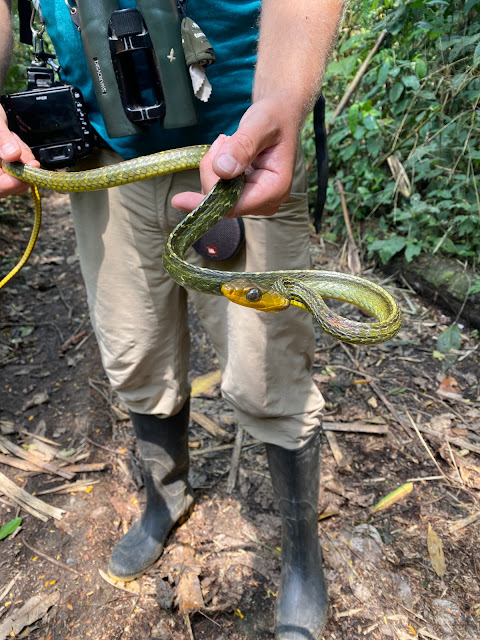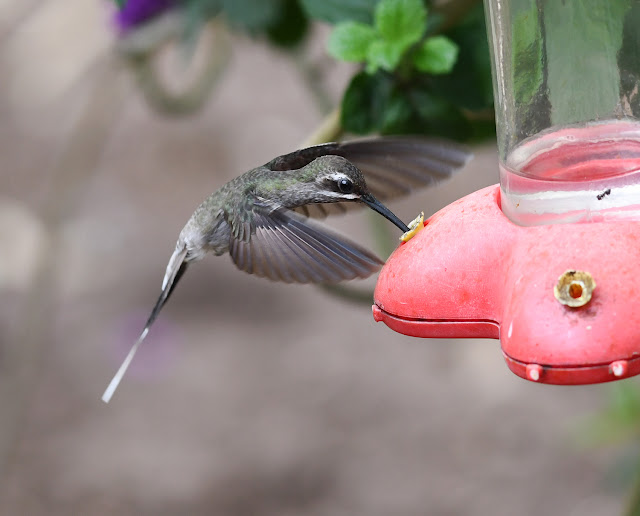September 3, 2022 (continued)
Our brief visit to the Wayqecha Cloud Forest Research Station was over too quickly and by the early afternoon, Laura and I were on our way down the mountain. We had booked two nights at another research station run by Amazon Conservation: the Manú Biological Station, formerly known as the Villa Carmen Biological Station.
The main draw for visiting birders is the extensive groves of spiny Guadua bamboo surrounding the station clearing. Bamboo stands may have less biodiversity than mature rainforest, but there are a number of bird species that spend most or all of their life in close association with bamboo. While Laura and I were hoping to find a wide array of biodiversity at Manú Biological Station, the bamboo specialist birds were high on our wish lists.
 |
| Guadua sp. - Manú Biological Station, Cusco, Peru |
Laura and I arrived at the station and were thrilled once again to be upgraded to our own cabin, even though we had booked the dormitory option to save money. Bonus!
That afternoon, we checked out a few of the trails which ventured into thick bamboo. We acquainted ourselves with some of the bamboo specialists, many of which were new species for us including Bamboo Antshrike and Goeldi's Antbird. A few Black-capped Tinamous vocalized from very close to the path but remained frustratingly out of sight.
 |
| Goeldi's Antbird - Manú Biological Station, Cusco, Peru |
One of the highlights at Manú Biological Station was the excellent food. We ate well, especially compared to our "trunk sandwiches" and other fare from earlier in the trip.
It was the caterpillars that really stole the show, including these impressive beasts.
Upon returning from a night-hike, weary and bleary-eyed, a jolt of energy always hits when I remember that I still have the moth sheet to check. What wonders will I behold?
The haul was relatively light but I still spent far too long marvelling at the insects when I should have been sleeping, given the 4:45 AM alarm set for the morning.
September 4, 2022
This would be a crucial day, our only full day at the Manú Biological Station. We were up before dawn, eager to hit the trails in time for the dawn chorus.
 |
| Purplish Jay - Manú Biological Station, Cusco, Peru |
We birded nearly every trail on the near side of the river throughout the day. Though the trail system at the Manú Biological Station is extensive, the trails on the far side of the river receive less regular maintenance and can be quite difficult to traverse. The near trails have been cut through bamboo and secondary forest.
 |
| Manú Biological Station, Cusco, Peru |
We found many of the speciality birds over the course of the day. The big prize was the White-cheeked Tody-Flycatcher, a scarce, range-restricted species which we saw well, though my photos are so terrible they don't really even count as record shots.
 |
| White-cheeked Tody-Flycatcher - Manú Biological Station, Cusco, Peru |
That's birding in the rainforest, however. Apart from at feeding stations, bird photography in these forests is extremely challenging given the thick foliage, poor lighting, and difficulty in approaching birds closely. Most of our best birds were documented rather poorly (if at all), even if the views through the binoculars were adequate.
 |
| Chestnut-tailed Antbird - Manú Biological Station, Cusco, Peru |
Antbirds were the theme of the day and we encountered some good ones including Manu Antbird, Black-spotted Bare-eye, and Brownish-headed Antbird (what colour is brownish, anyways?).
 |
| Black-spotted Bare-eye - Manú Biological Station, Cusco, Peru |
Flycatchers were well-represented and included our first McConnell's Flycatcher, Large-headed Flatbill and Dusky-tailed Flatbill. Another bamboo specialist remained heard-only: the Black-backed Tody-Flycatcher.
 |
| Large-headed Flatbill - Manú Biological Station, Cusco, Peru |
Without a doubt, the most beautiful bird in the entire Amazon basin is the Flammulated Pygmy-Tyrant. It just radiates with colour...
 |
| Flammulated Pygmy-Tyrant - Manú Biological Station, Cusco, Peru |
At least some of the birds actually contained colour, such as this Black-tailed Trogon.
 |
| Black-tailed Trogon - Manú Biological Station, Cusco, Peru |
Laura and I briefly crossed the river to explore a trail on the other side. This particular contraption allowed you to self-propel yourself across the watercourse. I guess it is a bit cheaper to build and easier to maintain than a bridge!
The trail on the far side of the river was in poor condition due to a relative lack of recent maintenance. We slogged uphill for a bit before cutting our losses. The only bird I photographed was this Yellow-breasted Warbling-Antwren. The wide trails through the bamboo on the lodge side of the river provided a much easier setting for birding, though I would imagine that a higher diversity of species could be found here on the far side of the river since the forest seemed more mature and diverse.
 |
| Yellow-breasted Warbling-Antwren - Manú Biological Station, Cusco, Peru |
As the birding slowed in the late morning, Laura and I partially diverted our attention in search of insects, and in particular, Lepidoptera.
 |
| Therinia sp. - Manú Biological Station, Cusco, Peru |
 |
| Catoblepia berecynthia - Manú Biological Station, Cusco, Peru |
 |
| Panacea prola - Manú Biological Station, Cusco, Peru |
Last evening’s haul of ridiculous caterpillars continued into today.
Another welcome diversion was caused by this South American Sipo, a new species for Laura and I. With some deft maneuvering I was able to apprehend it and avoid being bitten.
 |
| South American Sipo (Chironius multiventris) - Manú Biological Station, Cusco, Peru |
This snake was looking rather thin, possibly due its reduced vision as it appeared to be blind in one eye. Sipos are diurnal snakes that rely on vision for detecting prey.
 |
| South American Sipo (Chironius multiventris) - Manú Biological Station, Cusco, Peru |
This caterpillar is called Euphobetron cypris. Upon first noticing it, I wasn’t sure what exactly was going on. Upon closer inspection, it almost looks like this caterpillar made a suit out of smaller caterpillars!
 |
| Euphobetron cypris - Manú Biological Station, Cusco, Peru |
 |
| Euphobetron cypris - Manú Biological Station, Cusco, Peru |
While the birding along the trails was highly productive, the best bird photo opportunities presented themselves in the open areas near the lodge buildings. Hummingbird feeders were attended by nine different species, while the fruit feeders proved popular with the oropendolas, tanagers and Red-capped Cardinals.
 |
| White-bearded Hermit - Manú Biological Station, Cusco, Peru |
 |
| Sapphire-spangled Emerald - Manú Biological Station, Cusco, Peru |
 |
| Red-capped Cardinals - Manú Biological Station, Cusco, Peru |
 |
| Black-throated Mango - Manú Biological Station, Cusco, Peru |
While a high diversity of mammals can be found in the surrounding forests, one cannot expect to photograph too many during a short visit. Toppin's Titis and this Brown Capuchin were the only monkeys that I photographed here.
 |
| Brown Capuchin - Manú Biological Station, Cusco, Peru |
That evening was a repeat of the previous. I turned on the moth light and Laura and I set off on a short night walk after dinner followed by a check of the sheet. I finally managed a photo of one of the resident Tropical Screech-Owls. The Tawny-bellied Screech-Owls remained out of sight, though their frequent calls accompanied us on our walk as well as from the area surrounding our cabin.
 |
| Tropical Screech-Owl - Manú Biological Station, Cusco, Peru |
This leaf frog, of which we found several individuals, was the highlight of our night walk. Leaf frogs look like tree frogs and indeed, they are closely related. But leaf frogs are in the family Phyllomedusidae while tree frogs occupy Hylidae.
 |
| White-lined Leaf Frog (Phyllomedusa vaillantii) - Manú Biological Station, Cusco, Peru |
Leaf frogs are often big targets for herpers as many of the species are incredible in appearance, while others are quite rare. The famous Red-eyed Tree Frog of Central America is, contrary to its common name, in the leaf frog family.
 |
| White-lined Leaf Frog (Phyllomedusa vaillantii) - Manú Biological Station, Cusco, Peru |
Below are some of the other species I photographed that evening.
The sheet was relatively unproductive for a second straight night. I often find many more moths attending the sheet in mountainous areas, while lowland forests always produce fewer. I am not sure why that is.
That being said, there were still many novel species to marvel at this evening.
September 5
Our final morning at Manú Biological Station had arrived and I was determined to make the most of it. Though I had found most of my target bird species to this point, there were still some holes in my list including Peruvian Recurvebill, Scarlet-hooded Barbet, Amazonian Antpitta, Dusky-cheeked Foliage-gleaner, Fine-barred Piculet and several other more widespread species.
 |
| Caeruleuptychia aetherialis - Manú Biological Station, Cusco, Peru |
The morning started off well with decent looks at a pair of Dusky-cheeked Foliage-gleaners and a heard-only Peruvian Recurvebill during the dawn chorus. Laura joined me just after sunrise and we spent the rest of the morning exploring the trail system on the near side of the river. Though we had walked each of these trails several times already, new birds continued to appear.
 |
| Yellow-bellied Dacnis - Manú Biological Station, Cusco, Peru |
Tinamous are common by voice at Manú Biological Station but seeing them is a whole other matter. However, today would be a good tinamou day. Laura spotted a Little Tinamou on the path when she was on her way to meet up with me. Later, once we were birding together, we found this Cinereous Tinamou on a path.
 |
| Cinereous Tinamou - Manú Biological Station, Cusco, Peru |
A distant vocalization snapped me to attention. Could it be the barbet? A tense few minutes of waiting, and there it was – a male Scarlet-hooded Barbet. This colourful gem of a bird has a limited range, mainly in southeastern Peru as well as adjacent portions of Brazil and Bolivia.
 |
| Scarlet-hooded Barbet - Manú Biological Station, Cusco, Peru |
We encountered several other new species before finishing up for the morning. First up was a Fine-barred Piculet that played hide and seek with us for a while. Next was a Razor-billed Curassow vocalizing somewhere off the trail. Their deep hoots are felt more than they are heard.
 |
| Pectoral Sparrow - Manú Biological Station, Cusco, Peru |
More ridiculous caterpillars made appearances as well.
A quick scan of the river did not result in any hoped-for tapirs. We had to settle for poor looks at a Sunbittern, instead.
 |
| Sunbittern - Manú Biological Station, Cusco, Peru |
Laura and I enjoyed one final delicious meal and then checked out of the lodge. Before heading into town, we birded the entrance road for a bit. This proved to be an excellent decision as we found several more life birds: Large Elaenia and Red-billed Tyrannulet.
 |
| Large Elaenia - Manú Biological Station, Cusco, Peru |
Despite its drab appearance, the Red-billed Tyrannulet was a personal highlight as I have been hoping to pick out this uncommon species for a while now. This east-slope specialist is rather scarce in many areas, a somewhat surprising fact since it prefers secondary and degraded forest. This was the first eBird record for the Manú Biological Station hotspot.
 |
| Red-billed Tyrannulet - Manú Biological Station, Cusco, Peru |
And with that, we continued on to our accommodations in the nearby town of Pillcopata. This would be our base for four nights as we explored along Manú Road.














































No comments:
Post a Comment